|
Key to Genus Sporobolus R. Br.
|
|
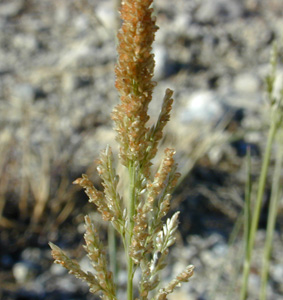
Grasses of the genus Sporobolus are relatively easily spotted in the field when in flower, having an inflorescence that is typically a long, narrow, cylindrical panicle (called a "rattail" in some species) crowded with simple, one-flowered spikelets (see photo at right). In the case of S. virginicus under ideal conditions, the inflorescence can be fairly thick (see Fig. 11C) rather than rattail-like; this native dune grass has been used for verge planting along Mokulele Highway on Maui and is the only Sporobolus in Hawai‘i that spreads by runners (rhizomes). The rest are clumping grasses and many are characterized by narrow (wiry) leaves. Many are difficult to distinguish (identify to species) unless examined closely under magnification.
Sporobolus diandrus starts out with the culm branches closely appressed to the axis (see Fig. 11A, at right) as in the other species, but the branches spread open as the flowers mature (see Fig. 11C, below; the same is somewhat true for S. pyramidatus). Sporobolus indicus, S. africanus, and S. fertilis are difficult to distinguish as characteristics of each tend to intergrade (Clayton & Snow, 2010). What we are calling, S. indicus, has become an exceedingly common ruderal species along roads in the Hawaiian Islands, particularly in dry to mesic environments. Sporobolus diandrus and, to a lesser extent, S. pyramidatus, are similarly common ruderals on calcarous soils.
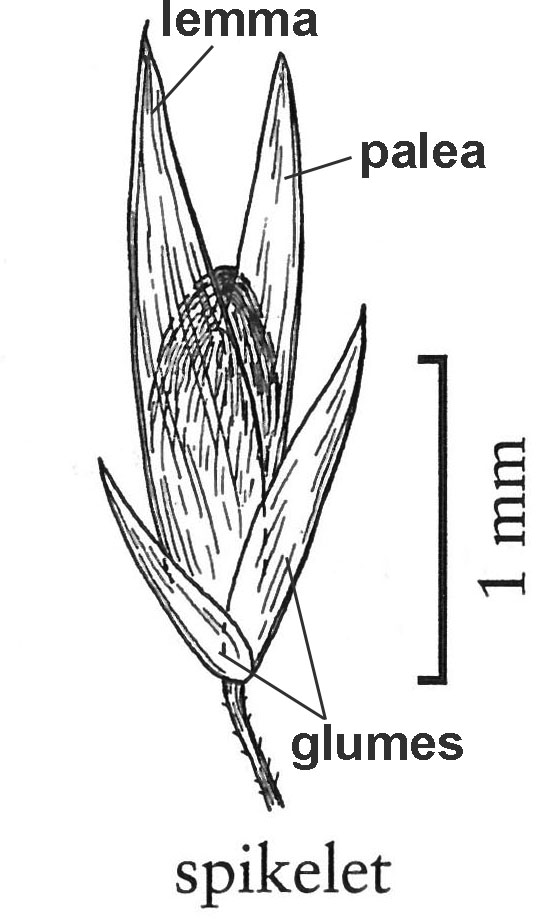 The spikelet of a Sporobolus is simple, consisting of a single floret encased in four floral bracts: two glumes, a lemma, and a palea (see Fig. 11B). Glumes are distinguished as first or lower glume and second or upper glume. In some species, the glumes may not be obvious except on very close examination, being short, tattered, and closely adherent against the lemma or palea. When the grain is released, the glumes are left behind; or all the floral bracts remain attached to the pedicel and the bracts left gaping.
The spikelet of a Sporobolus is simple, consisting of a single floret encased in four floral bracts: two glumes, a lemma, and a palea (see Fig. 11B). Glumes are distinguished as first or lower glume and second or upper glume. In some species, the glumes may not be obvious except on very close examination, being short, tattered, and closely adherent against the lemma or palea. When the grain is released, the glumes are left behind; or all the floral bracts remain attached to the pedicel and the bracts left gaping.
Figure 11B. Drawing of a spikelet of Sporobolus indicus copied
from the file: FNA25_P45_Sporobolus_pg_125.jpeg, floraofnorthamerica.org.
|
|
|
|
[GENUS SPOROBOLUS]
|
|
|
|
|
55a
|
(53) |
Perennial, clumping grasses. Leaves mostly crowded near the base, lax and/or wirey .. .
|
|
[56] |
|
55b
|
|
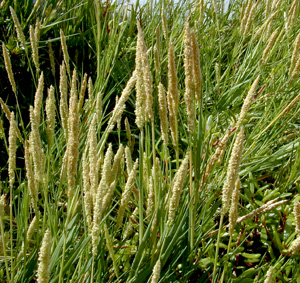
Figure 11C. Well-developed inflorescences
of ‘aki‘aki (Sporobolus virginicus) growing
under ideal conditions (S. virginicus var. phleoides).
Perennial, spreading grass, producing extensive stiff rhizomes. Leaves stiff, distinctly distichous (appearing or approximating two-ranked) in typical dune habitat. Leaves with scattered, long hairs on upper surface. Ligule a fringe of short, dense hairs. { Grass common along the marine shore and on coastal dunes from just above the high tide mark. Rarely flowers outside the ideal habitat near the ocean (Fig. 11C). Vegetative growth resembles Paspalum vaginatum and Distichlis spicata, species which also grow in or near saline water, the former densely lining estuarine shores. ‘aki‘aki, seashore rush grass, beach dropseed [HAW - IND] beach-dropseed, salt-grass, jatopa [GUM - NAT]
Sporobolus virginicus (L.) Kunth
|
|
|
~~~~ ~~~~~~~~~~~~~~~~~~~~~~~~~
|
|
|
56a
|
(55) |
Infloresences narrow panicles on tall culms extending outward (some geniculate) from a somewhat to greatly flattened basal rosette of narrow leaves. Lower panicle branches (at least lowermost sets) whorled. Upper glume as long as spikelet (1.8 - 2.5 mm); lower glume very short (0.4 mm). Ligule of short, stiff hairs (ciliate). { found in dry, leeward areas on limestone soils (Fig. 11E). [HAW - NAT]
Sporobolus pyramidatus (Lam.) Hitch.
|
|
56b
|
|
Panicle branches not whorled or, if lowermost set of branches whorled then glumes equal or subequal .. .
|
|
[57] |
|
~~~~ ~~~~~~~~~~~~~~~~~~~~~~~~~
|
|
|
57a
|
(56) |
Leaf collar and margins sparsely pilose (hairy); ligule membranous. Panicle narrow, but with branches spreading at maturity (see Fig. 11D, below). Floret with two stamens (best viewed at anthesis). Spikelets somewhat diffuse. { Small, perennial, clumping grass, widespread on disturbed sites, particularly coastal dry sites and limestone substrate (Figs. 11A, 11C). Indian dropseed [HAW - NAT] wire grass [GUM - NAT]
Sporobolus diandrus (Retz.) P. Beauv.
|
|
|
|
57b
|
|
Leaf collar and margins pilose OR without hairs (glabrous); ligule with fine hairs (ciliate or ciliolate). Panicle narrow, cylindrical, typically over 15 cm (6 in) long, branches held against the axis (appressed, upright) at maturity. Floret with two or three stamens. Spikelets very crowded .. .
|
|
[58] |
|
~~~~ ~~~~~~~~~~~~~~~~~~~~~~~~~
|
|
|
58a
|
(57) |
Spikelets greater than 1.5 mm long OR if <2 mm (1/16 in), then leaf sheath glabrous. Ligule a minute ciliate fringe. Stamens 3 per floret .. .
|
|
[59] |
|
58b
|
|
Leaf collar and sheath margins pilose (dense with hairs); ligule ciliolate (short dense hairs) on a low membrane. Spikelets elongate, acute, 1.8 to 2 mm long. Stamens 2 per floret. Glumes short, obtuse or erose, the upper about half the length of the spikelet, the lower shorter still. { Small clumping grass found as a weed in lawns and on disturbed sites, including dry coastal sites. Smutgrass [HAW - NAT] rat-tail dropseed [GUM - NAT]
Sporobolus elongatus R. Br.
|
|
|
~~~~ ~~~~~~~~~~~~~~~~~~~~~~~~~
|
|
|
59a
|
(58) |
Leaf sheath glabrous at margin below collar. Spikelets small, under 2 mm long (see Fig. 11B, above). Lemma and palea only a little longer than seed, not gaping. Fruit maturing brown. { Medium, perennial, clumping grass, found on disturbed sites from sea level up to 6200 ft (1890 m) elevation. West Indian dropseed, smutgrass. [HAW - NAT]
Sporobolus indicus (L.) R. Br.
|
|
|
59b
|
|
Leaf sheath pilose. Spikelets 2 to 3 mm long. Lemma and palea exceeding seed by its own length, gaping open. Fruit maturing red { Medium, perennial, wiry, clumping grass, widespread on disturbed sites and pastures above 500 ft (150 m) elevation. Smutgrass, African dropseed, rattail grass. [HAW - NAT] [GUM (Saipan) - NAT ]Sporobolus africanus (Poir.) Robyns & Tournay
|
|
|
|
|
Species of Sporobolus reported to be in Hawai‘i but not covered in this key:
S. fertilis (Steud.) Clayton - similar to S. indicus and S. africanus
S. piliferus (Trin.) Kunth - panicle branches whorled. No consistent
differences with S. pyramidatus.
Species of Sporobolus reported to be in the Marianas but not covered in this key:
S. ferinosus Hosok.
S. fertilis (Steud.) Clayton
S. pyramidalis P. Beauv.
|
|
SPOROBOLUS PHOTOS
[CLICK ON THUMBNAIL TO OPEN AN ENLARGED IMAGE]
|
|
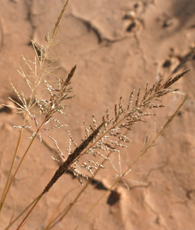
|
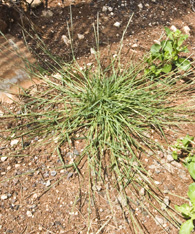
|
|
Figure 11D. Inflorescences of Sporobolus diandrus demon-
strating progressive spreading
open of branches upwards as
the head matures (0.5 MB).
|
Figure 11E. Typical habit of
Sporobolus pyramidatus
showing outwardly extended
culms (6.9 MB).
|
|